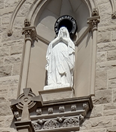Senses of Scripture: Difference between revisions
Appearance
No edit summary |
|||
| (3 intermediate revisions by the same user not shown) | |||
| Line 63: | Line 63: | ||
* see [https://www.usccb.org/bible/national-bible-week/upload/viviano-senses-scripture.pdf Viviano-SensesofScripture.indd (usccb.org)] | * see [https://www.usccb.org/bible/national-bible-week/upload/viviano-senses-scripture.pdf Viviano-SensesofScripture.indd (usccb.org)] | ||
[[Category:Catechism of the Catholic Church]] | |||
[[Category:Bible]] | |||
[[Category:Exegesis]] | |||
Latest revision as of 18:49, 28 January 2024
Also, the "Four Senses of Scripture"
Senses of Scripture: modes of interpretation[edit | edit source]
- "senses" refers to "meanings" (as in "that makes sense")
- "modes of interpretation" refers different ways to interpret
The "Four Senses of Scripture"[edit | edit source]
| Literal the direct meaning of the text |
Allegorical the metaphorical meaning or analogy presented by the tex |
| Moral (also called "Tropological") the moral lesson from the text, or lesson on difference between right and wrong |
Anagogical how to apply the lesson of the text into our lives and faith |
- Scripture frequently operates at multiple levels of "literal" (means exactly what it says) or "figurative" (it suggests or references something else or a larger idea)
- Augustine of Dacia (13th Century; CCC 118) taught:
The Letter speaks of deeds; Allegory to faith; The Moral how to act; Anagogy our destiny
Examples of employing the Four Senses of Scripture[edit | edit source]
Interpreting "Jerusalem"[edit | edit source]
| Mode or "sense" | Meaning |
|---|---|
| Literal | the city of the Jews |
| Allegorical | the Church created by Christ: the meaning of that Church |
| Moral (tropological) | Jerusalem as the human soul: what is the instruction God gives us? |
| Anagogical | Jerusalem as salvation: what we must do to get there |
"The Leaven of the Pharisees and Sadducees"[edit | edit source]
| Mode or "sense" | Meaning |
|---|---|
| Literal | Jesus tells the Apostles, “Look out, and beware of the leaven* of the Pharisees and Sadducees” and they say among themselves, “It is because we have brought no bread," thus taking Jesus' analogy literally.
The literal meaning is that the Pharisees and Sadducees use yeast in their bread, which transforms the bread from its original form (leaven, such as yeast, is used to make bread "rise"). |
| Allegorical | Jesus admonishes them, "You of little faith, why do you conclude among yourselves that it is because you have no bread?" And, in a rare moment in the Gospels, Jesus explains the analogy: "How do you not comprehend that I was not speaking to you about bread? Beware of the leaven of the Pharisees and Sadducees.” Thus, their "leaven" corrupts the teachings of God. |
| Moral | Beware of false teachers. |
| Anagogical | If we focus on Christ, we will not stray from God. |
